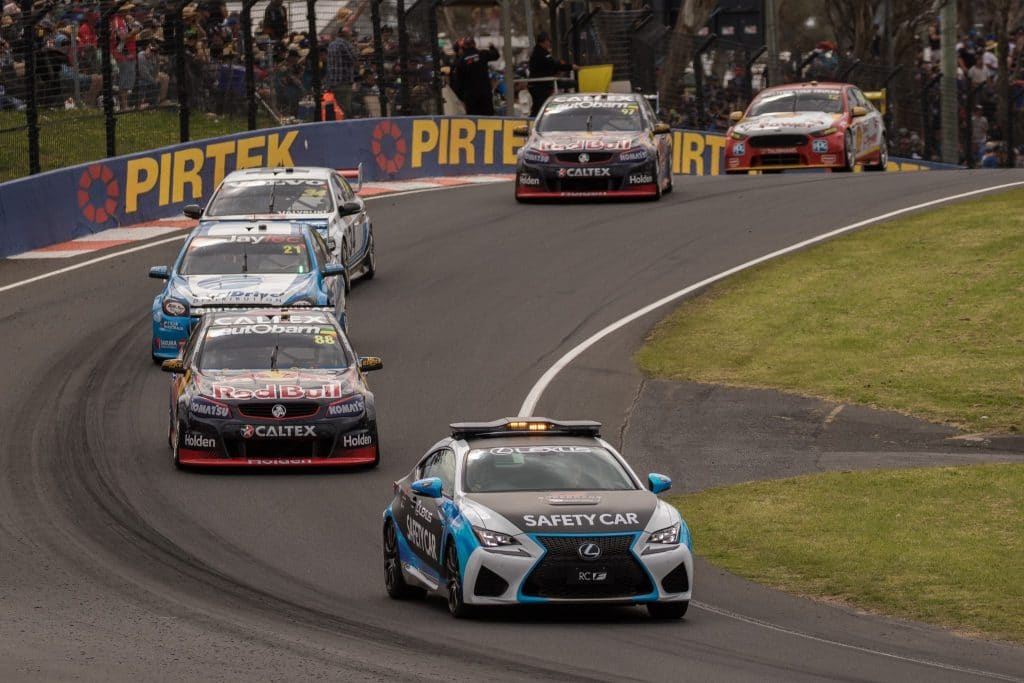Are Safety Cars actually that safe? Or are there alternatives that are both safer and fairer?
It’s a topic I’ve written about before, but after watching a total of 47 laps under Safety Car conditions during this year’s Bathurst 12 Hour, witnessing a workable alternative (the Code 60 system) at the recent Dubai 24 Hour and engaging in some passionate debate with a few of my fellow motorsport commentators, I decided it was time to re-open the discussion.
The Safety Car concept was introduced to the world at the 1973 Canadian Formula 1 Grand Prix, and made its first Australian appearance at the Bathurst 1000 in 1987.
It’s undisputable its introduction was a massive leap forward in terms of minimising the risk to drivers of crashed or stranded vehicles, not to mention trackside marshalls attending to these vehicles. Before the advent of the Safety Car, racing either continued at full speed (historical vision of race cars tearing past recovery trucks would be enough to make any modern-day OH & S assessor break out in a cold sweat) or, if an incident was serious enough, the race would stop altogether.
However, the Safety Car is certainly not perfect from either a safety or sporting perspective, and some of its imperfections were highlighted by renowned motorsport historian David Greenhalgh in an excellent analysis piece he wrote for the Chevron Great Race Bathurst 1000 preview magazine in 2014 – I actually caught up with David at the Bathurst 12 Hour and I was reminded of some of the key flaws he highlighted with Safety Cars.
Firstly, when Safety Car conditions are announced by race control, it takes time for the Safety Car to actually enter the circuit, as the race director or clerk of course endeavours to send it out at a time when it will pick up the right car – i.e. the race leader. This means cars are often racing at unabated speed for quite some time before coming under control.
Compounding this problem is the fact that, especially in long distance races, teams will choose to pit as soon as a Safety Car is called because there is a strategic benefit to be gained by doing so (doing a pit stop when the field is being slowed under Safety Car conditions costs less time relative to rivals than doing a pit stop when the field is travelling at full speed). This means cars exit the pits and drive at race pace to join the train of cars behind the Safety Car.
This situation – cars continuing to travel at high speeds even when the race is technically under control – means there is a considerable risk to drivers of stricken cars and officials attending to those cars.
Secondly, to reference a motorsport cliché, “Safety Cars breed Safety Cars” – i.e. because of the field compression, there is an increased propensity for other incidents to occur immediately after a restart, resulting in further Safety Car interventions.
There are no Safety Cars at the Dubai 24 Hour. Instead, there’s a caution protocol known as Code 60. In the event of an incident, drivers are given a 20-second countdown by which time they must adhere to a speed limit of 60km/h, enforced by monitoring how long it takes each car to travel between sector timing loops.
Code 60 neatly sidesteps the two safety issues described above. Firstly, because it can be activated within a 20 second window, it is a very quick process to bring the field under control, and because the speed limit applies to all vehicles at all times, the situation of having cars continuing at high speed is avoided.
Secondly, as there is no bunching of the field, the risk of incidents at a restart is significantly reduced. Safety Cars may breed Safety Cars, but Code 60s use very effective contraception.
Having seen Code 60 in effect at the Dubai 24 Hour, I have to say I’m a fan, and I didn’t mind extolling the virtues of the system to some of my commentary colleagues at the Bathurst 12 Hour.
Said colleagues were somewhat less enthusiastic than myself about the idea of introducing Code 60 here in Australia.
They pointed out that at a track like Mount Panorama, there are sections where 60 km/h may still be too fast, especially if a car is stopped at a blind corner like the Cutting or the Dipper.
My counter argument is that cars travelling at 60 km/h are still safer than cars travelling at race speed past an incident in these parts of the track, while they catch up to the Safety Car.
My esteemed colleagues also mentioned the entertainment factor of bunching up the field behind a Safety Car. This raises an issue that’s worthy of further discussion.
There’s no doubt that some of the grandstand finishes we have been treated to in races like the Bathurst 1000 have been brought about due to the appearance of late-race Safety Cars, and I would be lying if I said I didn’t enjoy calling some amazing sprints to the finish in endurance races after late Safety Car interventions, especially the 2013 and ’14 Winton 300s.
But do we really need this level of artificial intervention to create a spectacle? Or have we fallen so deeply into the trap of romanticising about exciting moments brought about by Safety Cars that we’ve forgotten to look at the big picture? Having reflected on these questions, I’m of the belief that those of us within the industry sometimes get so hung up on what we’re used to, and what we’re comfortable with, we forget about the wider sporting perspective.
In AFL or NRL, there’s no situation where the leading team has points deducted to create a close finish. Same goes for cricket. In an Olympic marathon, they don’t have a “safety runner” who comes onto the course to bunch up the field to make it a more exciting spectacle. And in motorcycle circuit racing, there’s no such thing as a Safety Bike. So why do we accept such a disruption to a pure sporting contest in circuit racing for cars?
It’s a pretty sad state of affairs if we lack that much confidence in our product to believe we need artificial intervention for the sake of entertainment. This is especially true in parity formula categories like Supercars, where the margins in qualifying are often unbelievably tight.
For all the good finishes created by Safety Cars, we lose sight of races where the entertainment value has actually been lessened by a Safety Car appearing at a bad time. And in multi-class races like the Bathurst 12 Hour, while Safety Cars might tighten up the outright contest, they can actually spread apart cars in non-outright classes.
Coming back to the Bathurst 1000 example, the propensity for a late-race Safety Car has become so frequent in recent years that teams have taken this into account in calculating their strategy. This has meant the opening stages of the race have often been quite dull, as teams have been focused on “buying a ticket” to the last hour, knowing that they just have to be somewhere in the lead bunch for the final sprint to the line.
What if the Code 60 system was implemented instead? What if teams knew they had to race hard all day, because if they lost too much ground to the lead car early in the race, they wouldn’t be able to make it back under an artificial field compression? Wouldn’t this make the entire race more intriguing, rather than only the ending? These are the sorts of questions that need to be asked when assessing the merits of various caution systems from an entertainment standpoint.
The differences in opinion between myself and my colleagues saw quite a lot of emotion and passion rising to the surface, but the bottom line is this: we are commentators who are very fortunate enough to talk about, and therefore have the chance to publicly express our opinion about such matters, but at the end of the day we’re not much more than glorified spectators; we’re not the ones affected by whatever caution system is used. What really counts is the point of view of the people whose safety may be affected by the decision to use Safety Cars or Code 60s – the drivers and the officials – so I sought the opinion of people representing these groups.
Caitlin Wood is a driver with experience racing under both Safety Cars and Code 60s, and she gave the Code 60 option the big thumbs-up.
“In multi-class races, I think Code 60 is definitely a safer option, because there are big differences between speeds and this can be a big issue at a Safety Car restart,” she said.
“Under a Code 60 there are more gaps between the cars, so when the race restarts it’s not so stressful for slower cars trying to get out of the way of faster cars.
“In the Dubai 24 Hour it was really easy for the drivers – we were given a countdown on the radio and knew exactly when we had to reach the 60km/h speed limit. We were given plenty of notice for when the race was going green again as well.
“They enforce the speed limit very strictly and the drivers are all very obedient because we know it’s a severe penalty for speeding.
“In the KTM I was racing, we had to manage the speed ourselves but I know a lot of the GT3 cars have a setting in their speed limiter to maintain 60km/h.
“For a big endurance race like the Dubai 24 Hour, I thought it worked a lot better than a Safety Car, and I think it would have worked well for the Bathurst 12 Hour – it might have even prevented some of the incidents we saw.”
I also spoke to an experienced clerk of course who chose not to be named, but was still prepared to offer some great insight. While open to the Code 60 concept, he said there are some hurdles to overcome.
Chief of these concerns is how the 60km/h speed limit would be enforced on Aussie tracks. For a circuit like Dubai, there are lots of micro-sector timing loops in the track, allowing each car’s speed can be measured at multiple points. Only measuring the cars once per lap is not good enough, because people would speed to the end of the lap when the Code 60 is first called.
Another concern is the fact that on a track like Bathurst with tight sections and blind corners, the officials might be able to execute a recovery more safely and easily with the field bunched up in one part of the track, rather than spread out.
I’m glad I had the conversation with the clerk of course as it opened my eyes to an alternative point of view, but here’s my response to his two concerns.
In regards to measuring speed of cars, I totally agree that it needs to be enforced to ensure both safety and fairness. At Queensland Raceway and Lakeside, they have a “clampdown” system (fundamentally very similar to Code 60) but because the speed of cars is not measured that accurately, bunching still occurs as some drivers’ definition of 60km/h is different to others. It might be fine for the events at those circuits, which are predominately for recreational racers competing at club level, but it wouldn’t be satisfactory for higher-profile national events where there is more at stake.
So my question is why, in this day and age, do we need to persist with timing loops to measure the speed of cars? Surely the technology exists to measure the speed of cars in closed-circuit competition with a GPS-based system? It would certainly be much cheaper than having to install thousands of dollars worth of timing loops in every racetrack.
In terms of officials being able to execute a recovery, again the technology exists to communicate with drivers to advise them of the situation. At Queensland Raceway and Lakeside, and increasingly at Wakefield Park and Winton, drivers are required to wear race receivers for events, whereby the clerk of course can communicate directly with the drivers. And for larger events at Bathurst there is a race management channel that serves a similar purpose.
So if a car was being recovered from a tricky position, the clerk of course could say over the race management channel: “Car stranded on driver’s left at the Cutting, all drivers keep far right”. And if the recovery is too hard to manage with any cars driving past, tell everyone to stop where they are on the circuit!
A couple of other advantages of Code 60 for those I haven’t convinced yet:
Racing can restart at any time, unlike a Safety Car where you have to wait until the end of a lap – this would be a significant time-saver on a long track like Bathurst and would result in an increase in green-flag racing.
And Code 60 can be used during practice and qualifying as well as racing, which avoids disrupting the flow of those sessions with red flags, having to wait for cars to return to pit lane, and then drivers struggling to find clear track to set a time when the session restarts.
Finally, for those like me who love the strategic variation created by endurance racing, Code 60 still presents a tactical element because there is an advantage to be gained by pitting under a Code 60, compared to green-flag conditions.
In conclusion, introducing a Code 60-type protocol should be the aim of Australian motorsport sanctioning bodies, event promoters and race categories because it has significant safety advantages over Safety Cars while also making motor-racing much more of a pure sporting contest – and aren’t these two objectives we should always be striving towards?
PHOTOS: Insyde Media





